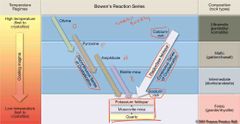![]()
![]()
![]()
Use LEFT and RIGHT arrow keys to navigate between flashcards;
Use UP and DOWN arrow keys to flip the card;
H to show hint;
A reads text to speech;
43 Cards in this Set
- Front
- Back
- 3rd side (hint)
|
Mineral |
A naturally occurring, inorganic solid with a definite composition/compositional range and fixed internal atomic (crystalline) structure |
|
|
|
Physical Characteristics of Minerals (8) |
1. Color 2. Streak 3. Hardness 4. Luster 5. Tenacity 6. Diaphaneity 7. Specific Gravity 8. Cleavage/Fracture **Bonus: The chemical composition and arrangement control these |
|
|
|
Tenacity |
A mineral's resistance to bending before breakage |
|
|
|
Diaphaneity |
How well a mineral transmits light - can range from transparent to opaque |
|
|
|
Specific Gravity |
The weight of a sample compared to the weight of the same mass of water |
|
|
|
Mineral Compositional Groups |
Native Elements: Copper, gold, sulfur, etc. Oxides: Metal + Oxygen Sulfides: Metal + Sulfur Sulfates: Metal + (SO4)-2 Carbonates: Metal + (CO3)-2 Halides: Metal + Halogens (Fl, Cl, Br, I) Phosphates: Metal + (PO4)-3 Silicates: Contains silicate group |
|
|
|
Cleavage |
The breaking or splitting of mineral crystals along planes of internal weakness |
|
|
|
Fracture |
An irregular break in a rock along a surface without a definite shape (not along planes) |
|
|
|
Silica Tetrahedron |

SiO4 |
|
|
|
Bowens Reaction Series |

|
|
|
|
Texture |
Refers to grain size of mineral crystals: larger grains = slower cooling |
|
|
|
Aphanitic Texture |
Fine grains |
|
|
|
Phaneritic Texture |
Grains visible to the naked eye |
|
|
|
Porphyritic Texture |
Cooling rate began at one rate and changed partway through, leading to differing grain sizes |
|
|
|
Glassy Texture |
Incredibly small grains due to very fast cooling rate |
|
|
|
Vesicular Texture |
“Bubbles” leftover in the rock from dissolved gases |
Think pumice |
|
|
Pegmatites |
Large crystalline growths due to a non-viscous magma (compounds can move past each other easier) |
|
|
|
Stages of Coal Formation |
1. Plant Material - partially alteredd, MUST be preserved, 2. Peat - Soft brown coal, compression begins, moderate energy 3. Lignite - Fine-grained 4. Biotuminous - soft, |
|
|
|
Sedimentary Rocks |
Created through chemical and physical weathering, account for 5% (by weight) of Earth’s outer 10mi of crust |
|
|
|
Lithification |
The process by which sediment is turned into solid rock by compaction and cementation |
|
|
|
Diagenesis |
Chemical, physical, and biological changes that take place after the sediments have been deposited. |
|
|
|
Clastic/Detrital Rocks |
Sediments transported from other rocks as solid particles |
|
|
|
Chemical Rocks |
Sediment that was once in a solution, and was precipitated |
|
|
|
Constituents of Clastics |
-Clay minerals -Quartz -Feldspars -Micas |
|
|
|
Sand Size |
1/16-2mm |
|
|
|
Conglomerate |
Consists of rounded gravels |
|
|
|
Stages of Coal Formation |
1. Peat 2. Lignite 3. Bituminous 4. Anthracite |
|
|
|
Stress Types |
Compression Tension Sheer |
|
|
|
Geothermal Gradient |
Increase in temperature with an increase in depth |
|
|
|
Uniform Pressure |
Pressure on rock is equal on all sides |
|
|
|
Differential Stress |
Stress differs directionally, can align grains/particles depending on direction of stress |
|
|
|
Compressional Deformation |
Aligns grains/particles perpendicular to stress |
|
|
|
Tensional Deformation |
Aligns grains/particles parallel to stress (pulling) |
|
|
|
Sheer Deformation |
Aligns grains/particles parallel to stress (sliding) |
|
|
|
Peat |
First stage of coal formation. Partially altered plant material, burns at a low energy. |
|
|
|
Lignite |
Second stage of coal formation. Soft brown coal burns at a moderate energy. |
|
|
|
Bituminous |
Third stage of coal formation. Soft black coal, high energy when burnt. Often used in industry and power generation. |
|
|
|
Anthracite |
Fourth stage of coal formation. Hard black coal often used industry and burnt at a high energy. This stage is metamorphic. |
|
|
|
Continental Sedimentary Environments |
Dominated by stream erosion and deposition (fluvial). Also includes glacial, wind (eolian), and lake (lacustrine) |
|
|
|
Marine Sedimentary Environments |
Shallow, from 0-200m. Includes the continental shelf. Deep, seaward of the continental shelf. |
|
|
|
Transitional Sedimentary Environments |
Shoreline environments, including tidal flats, lagoons, and deltas |
|
|
|
Sedimentary Structures |
Graded beds Ripple marks Mud cracks Fossils |
|
|
|
Metamorphic Rocks |
Rocks that have “changed shape” due to heat and pressure |
|

